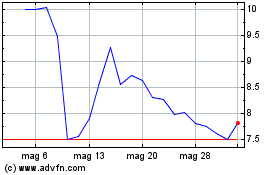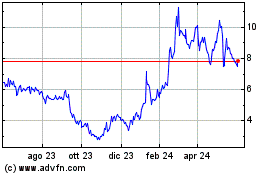Sana Biotechnology, Inc. (NASDAQ: SANA), a company focused on
changing the possible for patients through engineered cells, today
announced that Cell Stem Cell has published a paper titled
“Hypoimmune islets achieve insulin independence after allogeneic
transplantation in a fully immunocompetent non-human primate.” The
paper evaluated a transplant of Sana’s engineered allogeneic,
hypoimmune (HIP)-modified pancreatic islet cells into a fully
immunocompetent, diabetic non-human primate (NHP). These modified
islet cells, which cluster into effective endocrine organoids, are
termed “pseudo islet grafts” (p-islets). The results demonstrated
that the HIP-modified p-islets engrafted following intramuscular
injection and provided stable endocrine function, enabling insulin
independence in the absence of immunosuppression.
“The results of this preclinical study are remarkable, and if
they translate into the clinic, we have the potential to profoundly
change the way that type 1 diabetes is addressed, potentially
eliminating the need for insulin injections or immunosuppression,”
said Sonja Schrepfer, MD, PhD, Sana’s Head of Hypoimmune Platform.
“We look forward to insights from an investigator-sponsored trial
(IST), a first-in-human study of HIP-modified, allogeneic primary
islet cells later this year, which would serve as clinical
proof-of-concept to assess the safety, cell survival, immune
evasion, and C-peptide production of transplanted HIP-modified
primary islet cells without immunosuppression into a patient with
type 1 diabetes. This publication, along with the ongoing IST, will
provide invaluable insights toward our stem cell derived product
candidate, SC451. With more than 8 million patients with type 1
diabetes worldwide, there is an enormous need to cure – rather than
simply manage – this disease.”
“JDRF is dedicated to harnessing the power of research,
advocacy, and community engagement to advance life-changing
breakthroughs for type 1 diabetes,” said Sanjoy Dutta, PhD, JDRF
Chief Scientific Officer. “The development of cell therapies that
replace the loss of insulin-producing cells could one day offer
cures for type 1 diabetes. A key area of focus for JDRF is to
develop strategies to protect these cells after transplantation
that remove the use of broad immunosuppression. As a supporter and
investor in Sana through the JDRF T1D Fund, we look forward to
seeing if the results described in this paper translate into
people, as they would represent a meaningful advance in the
treatment of type 1 diabetes.”
The transplant setting was purposely designed to be a high
immunological bar by maximizing the donor-to-recipient mismatch.
Diabetes mellitus was chemically induced in the recipient as shown
by the development of major blood glucose instability and the need
for daily insulin injections to control blood sugar. Following
stabilization of glucose with insulin treatment, the diabetic NHP
underwent transplantation of the HIP p-islets without any induction
or maintenance immunosuppression and the administration of insulin
was tapered to zero over the course of nine days. Rapidly following
HIP p-islet transplantation, the diabetic NHP recipient showed
tightly controlled blood glucose levels, was completely
insulin-independent, continuously healthy, and exhibited no
physical or behavioral abnormalities for the six-month study
duration. C-peptide levels, which are a marker for endogenous
insulin production and release, reached the normal levels observed
prior to induction of diabetes. Furthermore, there was no
indication that the allogeneic HIP p-islet graft induced any immune
recognition or any type of immune response at any time.
To demonstrate that there was no regeneration or recovery of an
endogenous islet cell population in the diabetic NHP, HIP p-islets
were eliminated using an anti-CD47 antibody. The antibody blocked
the protective CD47 signal and triggered a “missing self” innate
immune cell response that led to the rapid destruction of the HIP
p-islet graft. Following the anti-CD47 treatment, blood glucose
levels in the diabetic NHP began to fluctuate and increase
markedly, and insulin injections needed to be resumed. It was thus
demonstrated that the tightly controlled blood glucose levels and
insulin independence was entirely due to well-functioning HIP
p-islets.
The publication is available for online viewing at
https://doi.org/10.1016/j.stem.2024.02.001.
About Hypoimmune PlatformSana’s hypoimmune
platform is designed to create cells ex vivo that can evade the
patient’s immune system to enable the transplant of allogeneic
cells without the need for immunosuppression. We are applying the
hypoimmune technology to both donor-derived allogeneic T cells,
with the goal of making potent and persistent CAR T cells at scale,
and pluripotent stem cells, which can then be differentiated into
multiple cell types at scale. Preclinical data published in
peer-reviewed journals demonstrate across a variety of cell types
that these transplanted allogeneic cells are able to evade both the
innate and adaptive arms of the immune system while retaining their
activity. Our most advanced programs utilizing this platform
include an allogeneic CAR T program targeting CD19+ cancers,
an allogeneic CAR T program for B-cell mediated autoimmune
diseases, an allogeneic CAR T program targeting CD22+ cancers, and
stem-cell derived pancreatic islet cells for patients with type 1
diabetes.
About Sana BiotechnologySana Biotechnology,
Inc. is focused on creating and delivering engineered cells as
medicines for patients. We share a vision of repairing and
controlling genes, replacing missing or damaged cells, and making
our therapies broadly available to patients. We are a passionate
group of people working together to create an enduring company that
changes how the world treats disease. Sana has operations in
Seattle, Cambridge, South San Francisco, and Rochester. For more
information about Sana Biotechnology, please visit
https://sana.com/.
Cautionary Note Regarding Forward-Looking
StatementsThis press release contains forward-looking
statements about Sana Biotechnology, Inc. (the “Company,” “we,”
“us,” or “our”) within the meaning of the federal securities laws,
including those related to the Company’s vision, progress, and
business plans; expectations for its development programs, product
candidates and technology platforms, including its pre-clinical,
clinical and regulatory development plans and timing expectations;
the potential of an anti-CD47 antibody to serve as a safety
strategy for Sana’s engineered allogeneic, hypoimmune
(HIP)-modified pancreatic islet cells; the potential impact if the
preclinical data translate into the clinic; the potential of the
publication and the IST to provide insights toward Sana’s SC451
program; the potential of Sana’s hypoimmune technology as a
treatment for diabetes; the ability to use the HIP platform to
create cells ex vivo that can evade a patient’s immune system and
enable the transplant of allogeneic cells without the need for
immunosuppression and the potential benefits associated therewith;
and the ability to apply the HIP technology to allogeneic T cells
to make potent and persistent CAR T cells at scale and to
pluripotent stem cells, which can then be differentiated into
multiple cell types at scale. All statements other than statements
of historical facts contained in this press release, including,
among others, statements regarding the Company’s strategy,
expectations, cash runway and future financial condition, future
operations, and prospects, are forward-looking statements. In some
cases, you can identify forward-looking statements by terminology
such as “aim,” “anticipate,” “assume,” “believe,” “contemplate,”
“continue,” “could,” “design,” “due,” “estimate,” “expect,” “goal,”
“intend,” “may,” “objective,” “plan,” “positioned,” “potential,”
“predict,” “seek,” “should,” “target,” “will,” “would” and other
similar expressions that are predictions of or indicate future
events and future trends, or the negative of these terms or other
comparable terminology. The Company has based these forward-looking
statements largely on its current expectations, estimates,
forecasts and projections about future events and financial trends
that it believes may affect its financial condition, results of
operations, business strategy and financial needs. In light of the
significant uncertainties in these forward-looking statements, you
should not rely upon forward-looking statements as predictions of
future events. These statements are subject to risks and
uncertainties that could cause the actual results to vary
materially, including, among others, the risks inherent in drug
development such as those associated with the initiation, cost,
timing, progress and results of the Company’s current and future
research and development programs, preclinical and clinical trials.
For a detailed discussion of the risk factors that could affect the
Company’s actual results, please refer to the risk factors
identified in the Company’s SEC reports, including but not limited
to its Quarterly Report on Form 10-Q dated November 8, 2023. Except
as required by law, the Company undertakes no obligation to update
publicly any forward-looking statements for any reason.
Investor Relations & Media:
Nicole Keithinvestor.relations@sana.commedia@sana.com
Grafico Azioni Sana Biotechnology (NASDAQ:SANA)
Storico
Da Dic 2024 a Gen 2025

Grafico Azioni Sana Biotechnology (NASDAQ:SANA)
Storico
Da Gen 2024 a Gen 2025
